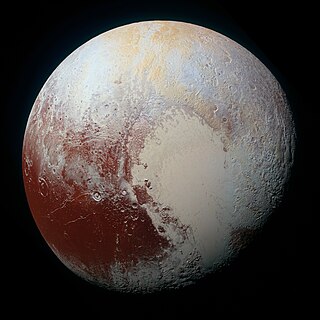Related Research Articles

Planetary nomenclature, like terrestrial nomenclature, is a system of uniquely identifying features on the surface of a planet or natural satellite so that the features can be easily located, described, and discussed. Since the invention of the telescope, astronomers have given names to the surface features they have discerned, especially on the Moon and Mars. To found an authority on planetary nomenclature, the International Astronomical Union (IAU) was organized in 1919 to designate and standardize names for features on Solar System bodies.

Petrarch is a crater on Mercury. This crater is located within the distorted terrain on the opposite side of the planet from the Caloris Basin. It was named after Petrarch, the medieval Italian poet, by the IAU in 1976.
The Alcyonides were, in Greek mythology, the seven daughters of the giant Alcyoneus.

Davies is a crater on Mars located at 46°N 0°E on the fringe of Acidalia Planitia near Arabia Terra. It is approximately 48 km in diameter. The crater's name was formally approved by the IAU in 2006.

Bečvář is a lunar impact crater that is located near the equator on the far side of the Moon. It lies to the northeast of the crater Necho, within that feature's ray system. To the north-northeast is the crater Gregory.

Mons Hadley is a massif in the northern portion of the Montes Apenninus, a range in the northern hemisphere of the Moon. It has a height of 4.5 km (2.8 mi) 14,764 ft (4,500 m) above the adjacent plain and a maximum diameter of 25 km at the base.

Gregory is a lunar impact crater on the far side of the Moon. It is located to the southeast of the crater Ibn Firnas, and north-northeast of Bečvář. About one crater diameter to the north is the smaller Morozov.
Stokes is an impact crater on Mars, located on the Martian Northern plains at 55.9°N latitude and 188.8°W longitude. It measures approximately 62.74 kilometres (38.98 mi) in diameter and was named after Irish physicist George Gabriel Stokes (1819–1903). The crater's name was officially adopted by IAU's Working Group for Planetary System Nomenclature in 1973.

In planetary nomenclature, a tholus is a small domical mountain or hill. The word is from the Greek θόλος, tholos, which means a circular building with a conical or vaulted roof. The Romans transliterated the word into the Latin tholus, which means cupola or dome. In 1973, the International Astronomical Union (IAU) adopted tholus as one of a number of official descriptor terms for topographic features on Mars and other planets and satellites. One justification for using neutral Latin or Greek descriptors was that it allowed features to be named and described before their geology or geomorphology could be determined. For example, many tholi appear to be volcanic in origin, but the term does not imply a specific geologic origin. Currently, the IAU recognizes 56 descriptor terms. Tholi are present on Venus, Mars, asteroid 4 Vesta, dwarf planet Ceres, and on Jupiter's moon Io.

Zola is a crater on Mercury. The crater was named after the French novelist and playwright Émile Zola by the IAU in 1979.

Matisse is an impact crater on the southern hemisphere of Mercury. Matisse takes its name from the French artist Henri Matisse, and it was named by the IAU in 1976.

Leopardi is a crater on Mercury. Its name was adopted by the International Astronomical Union in 1976. Leopardi is named for the Italian writer Giacomo Leopardi, who lived from 1798 to 1837.

Villa-Lobos is a crater on Mercury. Its name was adopted by the International Astronomical Union (IAU) on September 25, 2015. Villa-Lobos is named for the Brazilian composer Heitor Villa-Lobos.
References
- ↑ Gregory, Gazetteer of Planetary Nomenclature, International Astronomical Union (IAU) Working Group for Planetary System Nomenclature (WGPSN)
- ↑ Niobe Planitia, V-23, Mercator projection